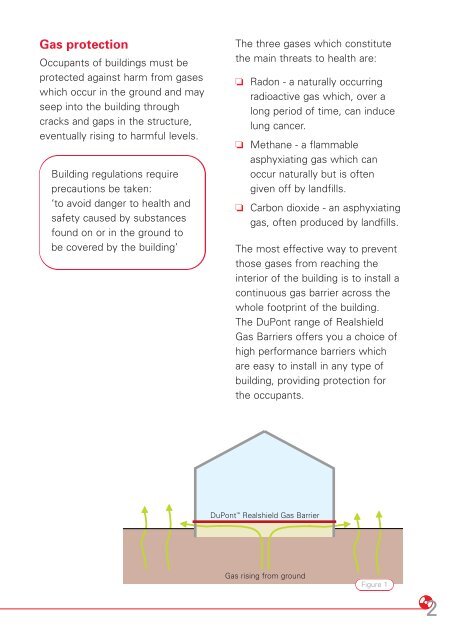Dupont Realshield.qxp (Page 1) - DuPont™ Tyvek
Dupont Realshield.qxp (Page 1) - DuPont™ Tyvek
Dupont Realshield.qxp (Page 1) - DuPont™ Tyvek
You also want an ePaper? Increase the reach of your titles
YUMPU automatically turns print PDFs into web optimized ePapers that Google loves.
Gas protection<br />
Occupants of buildings must be<br />
protected against harm from gases<br />
which occur in the ground and may<br />
seep into the building through<br />
cracks and gaps in the structure,<br />
eventually rising to harmful levels.<br />
Building regulations require<br />
precautions be taken:<br />
‘to avoid danger to health and<br />
safety caused by substances<br />
found on or in the ground to<br />
be covered by the building’<br />
The three gases which constitute<br />
the main threats to health are:<br />
❏ Radon - a naturally occurring<br />
radioactive gas which, over a<br />
long period of time, can induce<br />
lung cancer.<br />
❏ Methane - a flammable<br />
asphyxiating gas which can<br />
occur naturally but is often<br />
given off by landfills.<br />
❏ Carbon dioxide - an asphyxiating<br />
gas, often produced by landfills.<br />
The most effective way to prevent<br />
those gases from reaching the<br />
interior of the building is to install a<br />
continuous gas barrier across the<br />
whole footprint of the building.<br />
The DuPont range of <strong>Realshield</strong><br />
Gas Barriers offers you a choice of<br />
high performance barriers which<br />
are easy to install in any type of<br />
building, providing protection for<br />
the occupants.<br />
DuPont <strong>Realshield</strong> Gas Barrier<br />
Gas rising from ground<br />
Figure 1<br />
2


